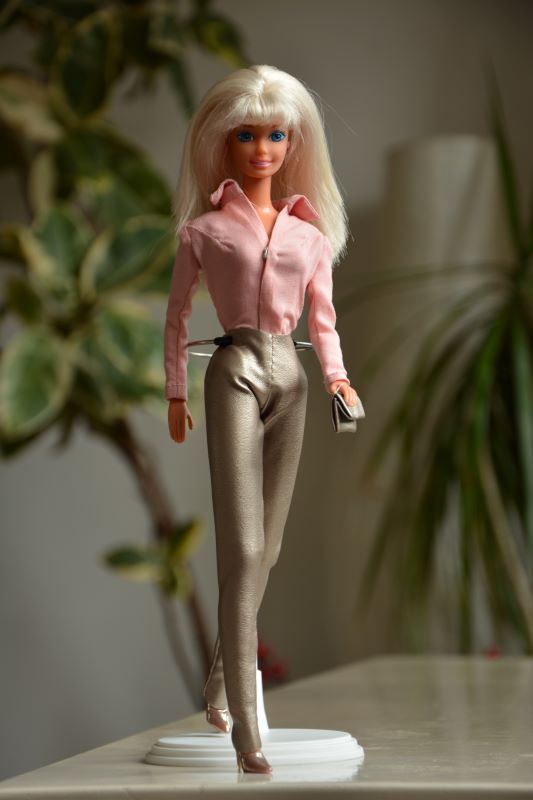Still form the film “Barbie”
| Weronika Cygan |
As estimated by scientists in the 1990’s, 99 percent of American girls aged three to nine owned at least one Barbie doll.[1]. In Poland the phenomenon never reached the scale known from the United states, the sight of little girls playing with the blonde plastic beauty was not, however, a rarity in Poland either.
Iconic around the world, the doll has recently received its first live action film, which is due to arrive in Polish cinemas this week. It is, as such, the perfect occasion to think about how big of an impact the toy has had on generations of children and on the idealised view of womanhood.
64 year old teen
In Greta Gerwig’s film, Barbie, played by Margot Robbie, takes off her high heeled shoes, and her foot retains the same shape, as if still stuck in the shoe. She is, after all, a doll – stiff, artificial, with an unreal physique. When, in a later scene, the heroine shows the already flat foot to her peers, they react with shock and disgust, because Barbie begins to appear more and more like a real human.
The film seems to laugh at the artificiality ascribed to Barbie and aims to show a clash of the character with the real world. Set on a distant voyage along with Ken (Ryan Gosling), tries to understand what real life means. The question stands though, whether the doll itself, and what has grown around her since her “birth” in 1959, can adapt to the present.
“Barbie is a character who is, at the very same time, fashionable and unfashionable” says Anna Gomóła, PhD DLitt, Assoc. Prof. from the Faculty of Humanities. “The defining property of fashion is its transience, whereas Barbie has already passed 64 years. She could be a grandma then, but she is not, she is always a teen. Barbie does not age, she changes her clothes, her hairstyles, cars or household equipment depending on a fleeting fashion, but she herself does not surrender to that fashion” states the researcher.
Barbie and her entourage
The entry of the Barbie doll onto the market was a revolution. Ruth Handler – the originator of the toy and the engineer of its success – presented it during the New York toy fair on the 9th of march 1959. During it, she employed an innovative sales and marketing strategy, e.g. showing the guests around by herself and selling them on her product. She knew that the interest and attention of the customer had to be won.
Barbie herself was not ordinary either. Her image had been worked on by an entire team of Mattel employees. Ruth Handler (born in the USA, a daughter of migrants from Warsaw) was a CEO of a firm she had co-founded with her husband – Elliot Handler. He was the one who came up with the idea of using new materials, and indeed, the process of making the doll was technologically advanced for the time. An excellent engineer and inventor, John Ryan was responsible for the construction of a model, the body of which had moving parts. The doll’s appearance and clothing was controlled by Charlotte Johnson, working in Japan, with the country’s seamstresses.
When we look at Barbie today, we associate it with something tacky or kitsch, but it is not how it has always been. “It should be approached with the perspective of a history of technology, materials science, industrial design and fashion. At the moment of its inception, it was something innovative, original and well prepared. The creation of a doll whose waist turns properly and has movable limbs required immaculate work. On top of that, it was made of vinyl, unlike its predecessor polystyrene German Bild Lilli. It was also well-dressed, with a carefully prepared set of outfits. Charlotte Johnson was a fashion designer who oversaw the quality of materials used and precision of workmanship”[2] explains prof. Anna Gomóła.
The “Barbie” doll helped spread a false, unreal portrayal of women | photo:. Elena Mishlanova, Unsplash
From the tobacconists’ to the salons
Right from its inception, Barbie has caused controversy. It is widely known that her original was the Bild Lilli doll, which Ruth Handler had spotted at one of the Swiss shops she visited during her stay in Europe. The Lilli doll was a “materialised” character from a comic created by the artist Reinhard Buthien, which appeared in the “Bild” newspaper since 1952. Lilli was absolutely not created with children in mind.
“It was sold in the tobacconists. It was more an addition to cigars and cognac and less a toy for little girls. It did not enjoy a good reputation. Elliot handler was convinced that the body type proposed for Barbie was inappropriate. His wife, however, was adamant: this was what girls wanted according to her” says the US scientist.
And indeed, once Barbie saw the light of day, it’s image was in many cases critiqued as too corporeal and shockingly sexualised (in Spain, the doll’s look was protested). The mass production and sale of Barbie was to effect a change: Mattel has transformed the relationship between the child and the toy. As the scientist stresses, from that point onward, little girls no longer had in their care dolls resembling children that had to be cared for, but a character shaping their view of adulthood.
False promises
Barbie makes only false promises. It entrenches in teens the belief that “they can be whoever they want”, not noting how much time and work one has to devote to becoming a specialist in some field.
“Barbie chooses different career paths, and each season this can be an entirely different field. She does not have to grapple with the consequences of that choice, whereas we know that in the case of more physically and mentally demanding vocations, this one choice is a choice for the entire life. We do not, unfortunately, learn this from Barbie. It is a vision of a person who can do what she wants and whose decisions do not have any consequences. It does not confront us with the passing of time and the transience of life” explains prof. Anna Gomóła.
Even when Mattel’s slim beauty takes up a physical job, and clambers into a farmer’s or a mechanic’s suit, she still looks spotless. We won’t see her dirty with grease or exhausted after a marathon. Her face is never tired after an hours-long shift. Her paramount duty is to look good, and in that, she represents a standard of beauty that is not even hard to reach, but rather impossible.
Half-hearted inclusivity
Under the pressure of accusations that the iconic doll’s body is too idealised, Mattel released three new models in 2016:tall, curvy and petite. Barbie was to finally promote diversity, and thanks to the curvy version – she was to have a less idealised figure. When her dimensions were calculated, and applied to an average healthy woman of equally average height, it turned out that the “curvy” Barbie has 63 cm at the waist and 91 cm at the hip. As can be seen, even the plus size model is entirely unrealistic for a real human[3].
Other attempts at inclusivity were not very successful either. In 2019 a doll in a wheelchair was released. Unfortunately the chair did not fit through the doors of the houses designed for previous models, which brought to attention the superficiality of such actions – the disadvantaged Barbie encountered on her way barriers hard to overcome. Dolls in a wheelchair or with hearing aids appeared in the Fashionistas line, which also incorporates eight eye colours and ten skin tones.
Prof. Anna Gomóła gives another example of Mattel’s dolls line, which were supposed to represent known and recognisable characters, whereas even they were shown to have unnatural proportions.
“Ella Fitzgerald was a person of rather full shapes, but she was represented in a way which made it hard to discern who it was supposed to represent. Frida Kahlo meanwhile is a person so unique that recognising her is easier, but even the previous barbies hadn’t had such slim hands” recalls the culture expert.
Will the newest “Barbie” film tackle the stereotype of a beautiful but hollow and artificial woman? | Still from the “Barbie” film trailer
Emanating barbie-ism
Ruth Handler managed to create a toy almost entirely hijacking a young person. Pedagogues call attention to the fact that in the case of products aimed at young children, their educational effect is always to be considered, even if their creators do not aim for them to have such an application. Meanwhile Barbie has shaped generations of girls, imprinting on them an idealised image of womanhood, supposedly adult but still infantile.
“Barbie prepares for constant, narcissistic exposure of oneself. For always being viewed from one’s best side. It is not a character who does something without being watched. Barbie is supposed to be watched, engaged in her world of eternal teenagehood. What has emanating barbie-ism led to? Seeing a role model in something which cannot (and, moreover, should not) be one” points out Prof. Anna Gomóła.
According to the researcher, Mattel’s product skewed the view of childhood in some way, and deprived children of a feeling of agency. Barbie, after all, was never an object of care, but only adoration. Girls who play with her are not to “rear” children-dolls into adulthood, but follow a young adult woman.
Will the newest “Barbie” film tackle the stereotype of a beautiful but hollow and artificial woman? Several decades of the doll’s existence shows that it is powerfully entrenched and it will be hard to root out. Maybe Barbie is simply irreformable, as the form in which it exists is so powerful that children cannot defend from it.
Endnotes
[1] Greenwald J., “Barbie Boots Up” in: „Time” 1996, vol. 148, nr 22.
[2] Gerber R., “Barbie and Ruth”, translated by Laskowska A., Białystok 2017.
[3] Bates C., “How does ‘Curvy Barbie’ compare with an average woman?” in: “BBC News Magazine”: http://www.bbc.co.uk/news/magazine-35670446?ns_mchannel=email&ns_source=inxmail_newsletter&ns_campaign=news_magazine_030316 [access: 20.07.2023].








